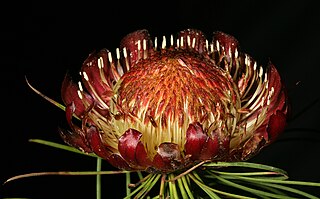
The Rubiaceae are a family of flowering plants, commonly known as the coffee, madder, or bedstraw family. It consists of terrestrial trees, shrubs, lianas, or herbs that are recognizable by simple, opposite leaves with interpetiolar stipules and sympetalous actinomorphic flowers. The family contains about 13,500 species in about 620 genera, which makes it the fourth-largest angiosperm family. Rubiaceae has a cosmopolitan distribution; however, the largest species diversity is concentrated in the tropics and subtropics. Economically important genera include Coffea, the source of coffee, Cinchona, the source of the antimalarial alkaloid quinine, some dye plants, and ornamental cultivars.

Trichomes, from the Greek τρίχωμα (trichōma) meaning "hair", are fine outgrowths or appendages on plants, algae, lichens, and certain protists. They are of diverse structure and function. Examples are hairs, glandular hairs, scales, and papillae. A covering of any kind of hair on a plant is an indumentum, and the surface bearing them is said to be pubescent.

Cinchona officinalis is a South American tree in the family Rubiaceae. It is native to wet montane forests in Colombia, Ecuador, Peru and Bolivia, between 1600–2700 meters above sea level.

Protea neriifolia, also known as the narrow-leaf sugarbush, oleander-leaved sugarbush, blue sugarbush, or the oleanderleaf protea, is a flowering plant in the genus Protea, which is endemic to South Africa.

Canthium is a genus of flowering plants in the family Rubiaceae. They are shrubs and small trees. The leaves are deciduous and the stems are usually thorny.
Keetia bakossiorum is a species of flowering plant in the family Rubiaceae. It is endemic to Cameroon. Its natural habitats are subtropical or tropical moist lowland forests and subtropical or tropical moist montane forests. It is threatened by habitat loss.
Keetia is a genus of flowering plants in the family Rubiaceae. It consists of climbers or scrambling shrubs, rarely small trees.
Keetia koritschoneri is a species of plant in the family Rubiaceae. It is endemic to Tanzania.
Keetia purpurascens is a species of flowering plants in the family Rubiaceae. It is endemic to Tanzania.

Vanguerieae is a tribe of flowering plants in the family Rubiaceae and contains about 655 species in 30 genera. It is one of the most species-rich groups within the family and it is distributed all over the Paleotropics.

Afrocanthium is a genus of flowering plants in the family Rubiaceae. It consists of deciduous, unarmed trees, and shrubs. They are native to East Africa, from Sudan and Ethiopia to South Africa.

Cadaba aphylla ("Swartstorm") is one of some 30 species in the genus Cadaba. It is indigenous to southern Africa.

Leucospermum gueinzii is an evergreen, upright shrub of 2–3 m (6–9 ft) high from the family Proteaceae. It has pointy lance-shaped to elliptic, eventually hairless, mostly entire leaves and egg-shaped, later flatter flower heads of about 12 cm in diameter, containing initially deep orange, later crimson flowers. From the center of each flower emerges a long style with a thickened tip, giving the entire head the appearance of a pincushion. Its flowers can be found between August and December. It is called kloof fountain-pincushion or shorter kloof pincushion in English. This is an endemic species restricted to a very small area near the south coast of the Western Cape province in South Africa.

Protea pendula, also known as the nodding sugarbush or arid sugarbush, is a flowering plant of the genus Protea, in the family Proteaceae, which is only found growing in the wild in the Cape Region of South Africa. In the Afrikaans language it is known as knikkopsuikerbossie or ondersteboknopprotea.

Protea sulphurea, also known as the sulphur sugarbush, is a flowering plant of the genus Protea in the family Proteaceae, which is only known to grow in the wild in the Western Cape province of South Africa. A vernacular name for the plant in the Afrikaans language is heuningkoeksuikerbos or Skaamblom.

Protea montana also known as the Swartberg sugarbush, is a flowering plant of the genus Protea within the family Proteaceae, which is endemic to the southwestern Cape Region of South Africa. In Afrikaans it is known as swartbergsuikerbos.

Protea burchellii, also known as Burchell's sugarbush, is a flowering shrub in the genus Protea, which is endemic to the southwestern Cape Region of South Africa.

Protea pityphylla, also known as Ceres sugarbush or mountain rose, is a flowering shrub of the genus Protea, in the family Proteaceae. The plant is endemic to the southwestern Cape Region of South Africa.

Protea decurrens, also known as linear-leaf sugarbush, is a shrub of the genus Protea, in the Proteaceae family, which is endemic to the southwestern Cape Region of South Africa. It is a small shrub with a thick underground rootstock, this structure throwing up numerous leafy branches, upon the base of which clusters of flower heads may appear close to the ground. It is pollinated by rodents and grows in low-altitude fynbos or renosterveld.
Tennantia is a monotypic genus of flowering plants belonging to the family Rubiaceae. It only contains one known species, Tennantia sennii(Chiov.) Verdc. & Bridson














